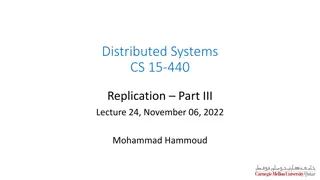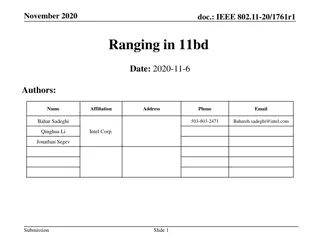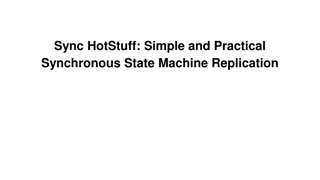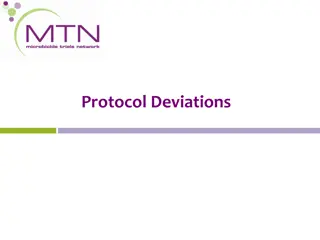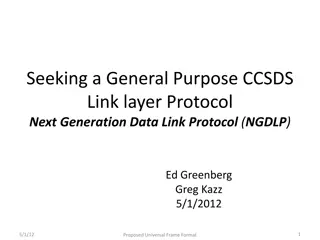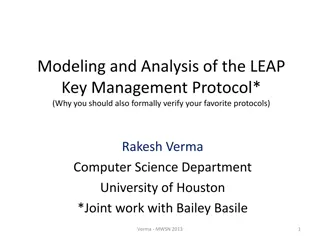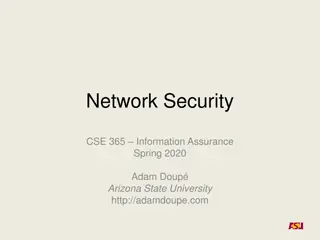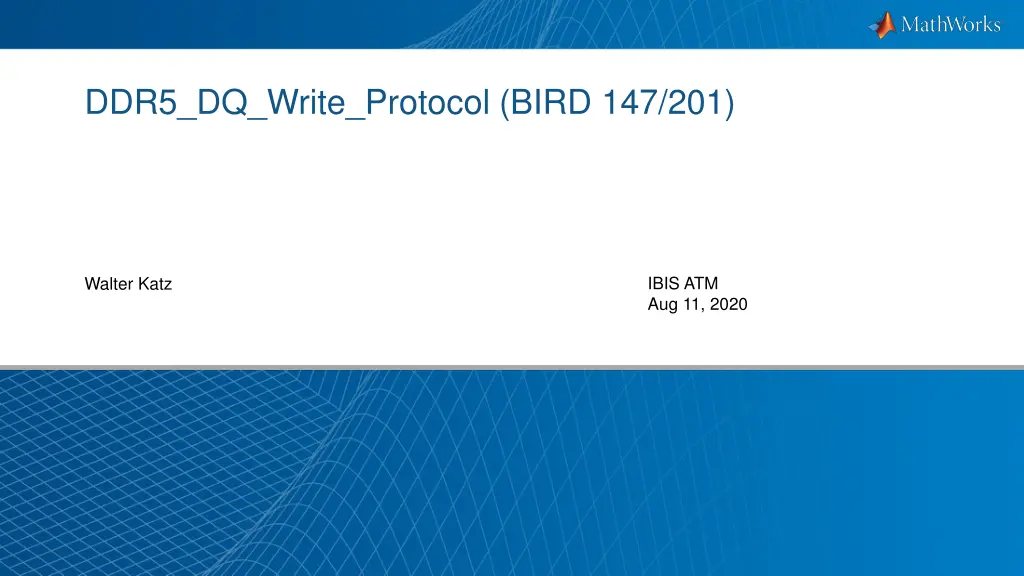
DDR5 DQ Write Protocol and Flow Optimization Overview
Explore the DDR5 DQ write protocol variations, support for BIRDs, and the general flow of BCI parameters in communication. Understand the communication methods between Tx and Rx, and the key parameters transferred during the process. Gain insights into the proposed DDR5 DQ write protocols and what information the Tx conveys to the Rx in different scenarios.
Download Presentation

Please find below an Image/Link to download the presentation.
The content on the website is provided AS IS for your information and personal use only. It may not be sold, licensed, or shared on other websites without obtaining consent from the author. If you encounter any issues during the download, it is possible that the publisher has removed the file from their server.
You are allowed to download the files provided on this website for personal or commercial use, subject to the condition that they are used lawfully. All files are the property of their respective owners.
The content on the website is provided AS IS for your information and personal use only. It may not be sold, licensed, or shared on other websites without obtaining consent from the author.
E N D
Presentation Transcript
DDR5_DQ_Write_Protocol (BIRD 147/201) IBIS ATM Aug 11, 2020 Walter Katz 1
Pushback on Rx Calculating Metrics Support for BIRDs 197 and 204 I had several requests to not define metrics that the Rx would calculate from its output impulse response or waveform. I therefor modified the protocol so that: Rx AMI_Impulse will now return the impulse response to the Tx AMI_Impulse Rx AMI_GetWave will now return the wave and clock_times to the Tx AMI_GetWave Added support for BIRD 197 DC_Offset and BIRD 204 DQ_DQS GetWave Flow for Clock Forwarding Modeling I also indicated which parameters are required and which were optional in the BCI_Parameters_Out strings. I also added a slide on an optimization flow and the interaction of this protocol with BIRD 204 and BIRD 197 2
General BCI Flow (BIRD 147/201) 1. Tx_Read BCI_Parameters_In is Rx BCI_Parameters_Out 2. Tx_Write makes Tx BCI_Parameters_Out 3. Rx_Read BCI_Parameters_In is Tx BCI_Parameters_Out 4. Rx_Write makes Rx BCI_Parameters_Out 5. If BCI_State is still Training then go to Step 1 above. (Note, BIRD 147 communications use file I/O, BIRD 201 communicates use **BCI_Parameters_Out and *BCI_Parameters_In) 3
BCI_Parameters_In and BCI_Parameters_Out Strings The AMI_Impulse functions communicate by outputting a pointer to a string. The contents of this string is called the BCI_Parameters_Out String . The AMI_GetWave functions communicate by outputting writing a file. The contents of this file is also called the BCI_Parameters_Out String . 4
I Am Proposing Two DDR5_DQ_Write Protocols DDR5_DQ_Write_JEDEC Tx communicates to Rx DFE tap registers Rx communicates to Tx DFE tap registers used, DFE tap coeficients used and Rx impulse_response (or wave) output DDR5_DQ_Write_Generic Tx communicates to Rx DFE tap coefficients Rx communicates to Tx DFE tap registers used, DFE tap coeficients used and Rx impulse_response (or wave) output 5
What the Tx Tells the Rx Each Time (DDR5_DQ_Write_JEDEC_Tx (Sequence 17) (Gain_Register 4) (VrefDQ_Register 35) (DFE_Register (1 4) (2 1) (3 4) (4 3)) (DQS_Skew 0.) ) (DDR5_DQ_Write_Generic_Tx (Sequence 17) (Gain_Value 1.2) (VrefDQ_Value 0.8) (DFE_Coefficient (1 -.3) (2 .05) (3 .04) (4 .03)) (DQS_Skew 0.) ) Required Required DFE_Register, Gain_Register, Sequence DFE_Coefficient, Gain_Value, Sequence Optional Optional VrefDQ_Register, DQS_Skew VrefDQ_Value, DQS_Skew 6
What the Rx Tells the Tx Each Time (DDR5_DQ_Write_JEDEC) AMI_Impulse AMI_GetWave (DDR5_DQ_Write_JEDEC_Rx (Sequence 18) (Gain_Value 1.2) (VrefDQ_Value 0.8) (DFE_Register (1 4) (2 1) (3 4) (4 3)) (DFE_Coefficient (1 -.3) (2 .05) (3 .04) (4 .03)) (DC_Offset 0.8) (DQS_in_clock_times False) (Impulse_Response (<voltage>) (<voltage>) (<voltage>) ) ) (DDR5_DQ_Write_JEDEC_Rx (Sequence 18) (Gain_Value 1.2) (VrefDQ_Value 0.8) (DFE_Register (1 4) (2 1) (3 4) (4 3)) (DFE_Coefficient (1 -.3) (2 .05) (3 .04) (4 .03)) (wave (<voltage>) (<voltage>) (<voltage>) ) (clock_times (<time>) (< time >) (< time >) ) ) Required Required Impulse_Response, Sequence Optional Gain_Value, VrefDQ_Value, DFE_Register , DFE_Coefficient, DC_Offset, DQS_in_clock_times Wave, Sequence Optional Gain_Value, VrefDQ_Value, DFE_Register , DFE_Coefficient, clock_times 7
What the Rx Tells the Tx Each Time, DDR5_DQ_Write_Generic AMI_Impulse AMI_GetWave (DDR5_DQ_Write_Generic_Rx (Sequence 18) (Gain_Register 4) (Gain_Value 1.2) (VrefDQ_Register 35) (VrefDQ_Value 0.8) (DFE_Register (1 4) (2 1) (3 4) (4 3)) (DFE_Coefficient (1 -.3) (2 .05) (3 .04) (4 .03)) (DC_Offset 0.8) (DQS_in_clock_times False) (Impulse_Response (<voltage>) (<voltage>) (<voltage>) ) ) Required Impulse_Response, Sequence Optional Gain_Value, VrefDQ_Value, DFE_Register , DFE_Coefficient, DC_Offset, DQS_in_clock_times (DDR5_DQ_Write_Generic_Rx (Sequence 18) (Gain_Register 4) (Gain_Value 1.2) (VrefDQ_Register 35) (VrefDQ_Value 0.8) (DFE_Register (1 4) (2 1) (3 4) (4 3)) (DFE_Coefficient (1 -.3) (2 .05) (3 .04) (4 .03)) (wave (<voltage>) (<voltage>) (<voltage>) ) (clock_times (<time>) (< time >) (< time >) ) ) Required Wave, Sequence Optional Gain_Value, VrefDQ_Value, DFE_Register , DFE_Coefficient, clock_times 8
Tx is Responsible for Determining Goodness of Result from the Impulse Response Output of Rx AMI_Impulse or the Waveform Output of Rx AMI_GetWave The sample spacing of the impulse response and waveform is determined by the EDA tool and passed to the algorithmic model through the AMI_Init function s sample_interval argument. clock_times is optional, and contains the same values as in the *clock_times output of the Rx AMI_GetWave The impulse response output of the Rx AMI_Impulse is converted to a pulse response by convolving it with a unit impulse response. There are numerous methods to convert a pulse response to a statistical eye or eye contours. The Tx model maker can choose any number of metrics that can be extracted from a statistical eye or eye contours (e.g. mean eye height, eye height, eye area, eye width, signal to noise ratio, COM at a specified BER). The waveform output of the Rx AMI_GetWave can easily be converted to an inner eye contour and an outer eye contour. The Tx model maker can choose any number of metrics that can be extracted from a statistical eye or eye contours (e.g. mean eye height, eye height, eye area, eye width, signal to noise ration, COM). The number of UI that are accumulated by the Tx AMI_GetWave to generate eye contours determines the BER of the eye contours. 9
Notes on Sequence Sequence is an internal check that the BCI_Parameters_In string that is input to AMI_Impulse or the BCI_ID file that is read by AMI_GetWave has been changed since the last time AMI_Impulse or AMI_GetWave was called. Problems indicated by Sequence not incremented propery: Other DLL is not generating BCI_AMI_Parameters_Out correctly EDA tool is not properly transferring the BCI_AMI_Parameters_Out string of one AMI_Impulse to the BCI_AMI_Parameters_In of the other AMI_Impulse AMI_GetWave not properly writing out BCI_ID file File system is not properly flushing the BCI_ID file 10
AMI_GetWave Files names Written by Tx and Rx <BCI_ID> the the string value of the AMI Reserved Parameter BCI_ID The Tx AMI_GetWave shall write the file <BCI_ID>.Tx.txt The Rx AMI_GetWave shall write the file <BCI_ID>.Rx.txt 11
VrefDQ_Register and VrefDQ_Value Rules VrefDQ_Register and VrefDQ_Value are ignored by the Rx if the Reserved Parameter DC_Offset is not specified in the Rx .ami file. If DC_Offset is specified in the Rx .ami file If the Tx does not specify VrefDQ_Register or VrefDQ_Value, then the Rx should choose an optimal VrefDQ_Register and/or VrefDQ_Value and output these values in its BCI_Parameters_Out string. If the Tx does specify VrefDQ_Register or VrefDQ_Value, then the Rx should use those values and output the actual values used in its BCI_Parameters_Out string. 12
Rx May Return Values When Tx Requests a Register and Return a Register When Tx Requests a Value For DDR5_DQ_Write_JEDEC The Rx shall contain a table that maps legitimate JEDEC register integer values to float values of the following VrefDQ Gain DFE Taps The Rx may return these float values in its BCI_Parameters_Out string For DDR5_DQ_Write_Generic The Rx may contain a table that maps legitimate JEDEC register integer values to float values of the following VrefDQ Gain DFE Taps The Rx may return the register and float values in its BCI_Parameters_Out string 13
What if the Rx supports BIRD 204 (DQ_DQS GetWave Flow for Clock Forwarding Modeling) In the hardware, the skew between DQ and DQS needs to be adjusted to center the DQS at the DQ eye at the latch. Adjusting this skew not only affects where the DQ is sampled at the latch, but also affects when the DFE taps get latched. How does the Tx AMI_GetWave know that the Rx DQ has a DQS input Added DQS_in_clock_times False How does the Tx AMI_GetWave adjust the DQS/DQ skew Added DQS_Skew 14
Standard Initialization of AMI_Impulse Calls, Interaction With BIRD 204 (DQ_DQS Clock Forwarding) and BIRD 197 (DC_Offset) On the first call to the Tx AMI_Impulse, the Tx shall turn off all its equalization, and in its BCI_Parameters_Out string direct the Rx to set the Rx Gain to zero dB and all Rx DFE taps to zero. The Rx can tell the Tx the value of DC_Offset and if DQS is input to Rx AMI_GetWave *clock_times The Tx AMI_Impulse can then choose starting point for Tx equalization, VrefDQ, Rx Gain and Rx DFE taps and search for a better solution. In time domain simulation the Tx AMI_GetWave can then continue to search Tx equalization, DQS skew, Rx Gain and Rx DFE taps for a better solution. If this is GetWave only BCI training, then the first calls to AMI_GetWave are used to communicate the DC_Offset and Rx AMI_GetWave DQS is input in clock_times. 15
Next Steps IBIS has left open how BCI Protocols are: Published Approved Amended I would like to proceed by documenting these two protocols, working out the document in IBIS-ATM, and publishing the document in the Open Forum. The Open Forum can proceed to approve the protocol as suggested in section 10.9 of the IBIS standard. 16


